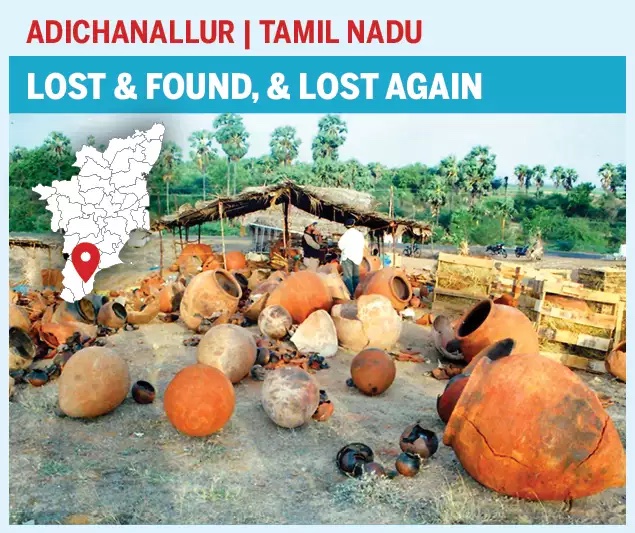Adichanallur
This article has been extracted from THE IMPERIAL GAZETTEER OF INDIA , 1908. OXFORD, AT THE CLARENDON PRESS. |
Note: National, provincial and district boundaries have changed considerably since 1908. Typically, old states, ‘divisions’ and districts have been broken into smaller units, units, and many tahsils upgraded to districts.Many units have since been renamed. Therefore, this article is being posted mainly for its historical value.
Adichanallur
Village in the Srivaikuntam taluk of Tinnevelly Dis- trict, Madras, situated in 8° 38' N. and 77 50' E., on the right bank of the Tambraparni river, 3 miles west of Srivaikuntam and 15 miles from Palamcottah. Excavations conducted by Mr. Rea, the Superintendent of the Archaeological Survey, in 1899 and the following years, have shown that this is the most extensive and important prehistoric burial- place as yet discovered in Southern India. Hundreds of ancient sepul- chral urns have been unearthed in a long piece of high ground on the south bank of the river, about 100 acres of which have new been marked off by Government and protected from molestat on until the excavations shall have been completed.
In this ground the urns are found at an average distance of only 6 feet apart, and at from 3 to 10 feet or more below the surface. In the centre, about 3 feet of the surface soil is composed of gravel with decomposed quartz rock below. The rock has been hollowed out for the urns, a separate cavity being prepared for each and a band of rock left between it and the next. The chambers thus made have preserved their contents in an almost perfect condition ; and from those which have so far been opened, representing only a small fraction of the whole, have been taken, besides the bones and skulls of the dead, more than 1,200 objects, including many unique and curious specimens of work in bronze and iron, pottery, and some pure gold ornaments.
The iron articles found comprise large bracketed and small hanging lamps, swords, spears, knives, adzes, celts, hammers, rings, bangles, beam rods, tridents, tripods, axes, arrows, chisels, &c, &c. Those made of bronze include small cups, moulded and ornamented jars, flat bowls and platters, and some curious lamps. Some of the pottery vessels are of exquisite shape and moulding, with a fine glaze. These finds have been deposited in the Madras Museum.
A tradition asserts that near this site was a most extensive town, and the deposits above described seem to support it. Mr. Rea thinks that the place might have been a Pandyan town, as from many observations he has made this mode of urn-burial appears to have been that adopted by the Pallavas and Pandyas. Further excavations are still going on at Adichanallur, and they will probably lead eventually to more definite results.
Status in 2020

From: Ajay Sura, Nimesh Khakhariya, Kangkan Kalita, M T Saju & Sandeep Rai, February 24, 2020: The Times of India
A prehistoric cemetery, Adichanallur in Tamil Nadu’s Thoothukudi district, is the oldest site in the state. Between 1900 and 1905, Alexander Rea of the ASI surveyed the site and prepared a map for it. While several artefacts excavated from the site were listed by Rea back then, there is no record of them now. Conservationists say the “missing artefacts” need to be located before a museum is established. “No one has any idea about what happened to artefacts listed by Rea. Other artefacts found during the colonial era are housed in Ethnological Museum of Berlin and they should be recovered too. Otherwise we only have artefacts excavated between 2004 and 2006,” said S Rajavelu, former epigraphist at ASI.
Excavations between 2004 and 2006 at Adichanallur had found remains of 85 human skeletons placed in a squatting position in giant clay urns. In 2003, an urn was found to date back to 696-540; another to 905-806BC.
But most conservationists agreed that an on-site museum was a great idea. T Sathyamurthy, former superintending archaeologist of ASI who headed an excavation in 2004, said it would help the site get the importance it deserves. Sathyamurthy pointed out how Arikamedu in Puducherry, one of the earliest Roman sites in the Tamilakam, lost its significance after being excavated in 1945-50 due to lack of an on-site museum.
While Adichanallur site spans 80 hectares — according to Rea’s survey — only 23 hectares has been identified as protected area. The remaining area has been encroached upon, with even a railway track running through the site.